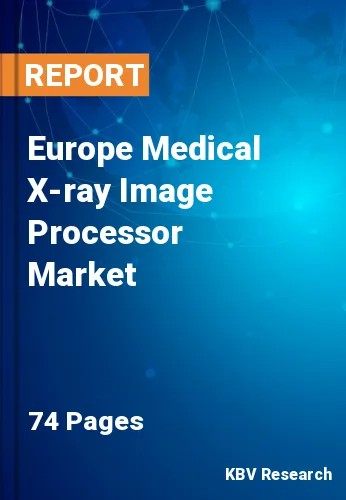The Europe Medical X-ray Image Processor Market would witness market growth of 2.2% CAGR during the forecast period (2023-2029).
X-rays are used to evaluate the position and growth of teeth, the structure of the jawbone, and the soft tissues of the mouth to determine whether orthodontic treatment is necessary. This aids dentists in deciding whether orthodontic treatment is required. In addition, X-rays are used to pinpoint the ideal location for dental implants, ensuring that they are successfully placed within the jawbone.
Additionally, the market is anticipated to rise as a result of expanding technological developments in X-ray image processors and their application in other fields, including dentistry. Using software applications to improve and analyze digital X-ray images of teeth, gums, and other oral tissues is one example. With the use of this software and processor, dental experts and dentists may detect and treat dental diseases more precisely and successfully by enhancing the clarity, contrast, and quality of the images.
The rise in minimally invasive procedures, surgical operations, and dental procedures are all contributing factors to the market expansion. The market for medical X-ray image processors is also predicted to grow in the coming years as a consequence of a number of factors, such as the increase in chronic diseases, traumatic events like accidents, and the development of new imaging technologies. Road accidents claim the lives of millions of people every year, increasing the need for X-rays and driving up the need for X-ray image processors.
In 2016, 2,977 people in England received an oropharyngeal cancer diagnosis, with oropharyngeal cancer incidence rates rising quickly in all four UK countries. Oropharyngeal cancer rates have surpassed those for oral cavity cancer in Wales, and oropharyngeal cancer has been identified as cancer with the quickest rate of increase in Scotland. Oropharyngeal cancer risk is over three times greater in men than in women and over three times more in people from socioeconomically impoverished areas than in those from more affluent areas. The high cases of oral diseases like mouth cancer and oropharyngeal cancer, which can be effectively diagnosed with X-ray, will increase the utilization of image processors, thereby aiding the market expansion in Europe.
The Germany market dominated the Europe Medical X-ray Image Processor Market by Country in 2022, and would continue to be a dominant market till 2029; thereby, achieving a market value of $67.1 Million by 2029. The UK market is anticipated to grow at a CAGR of 1.4% during (2023 - 2029). Additionally, The France market would exhibit a CAGR of 3% during (2023 - 2029).
Based on End User, the market is segmented into Hospitals, Outpatient Facilities and Research & Manufacturing. Based on Product, the market is segmented into Cassette and Flat Panel Detectors. Based on Application, the market is segmented into Orthopedic, Mammography, Dental, and Others. Based on countries, the market is segmented into Germany, UK, France, Russia, Spain, Italy, and Rest of Europe.
Free Valuable Insights: The Worldwide Medical X-ray Image Processor Market is Projected to reach USD 994.3 Million by 2029, at a CAGR of 2.8%
The market research report covers the analysis of key stake holders of the market. Key companies profiled in the report include Baker Hughes Company, Konica Minolta, Inc., Agfa-Gevaert Group, Fujifilm Holdings Corporation, Carestream Health, Inc. (Onex Corporation), Zimed Healthcare, Inc., Euroteck Systems UK Ltd, Hexagon International (GB) Ltd, AFP Manufacturing Corporation and PROTEC GmbH & Co. KG.
By End User
By Product
By Application
By Country
Our team of dedicated experts can provide you with attractive expansion opportunities for your business.

